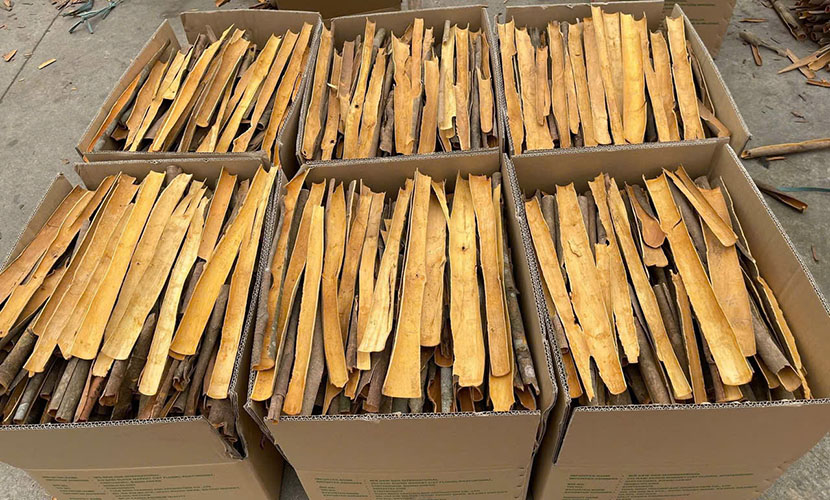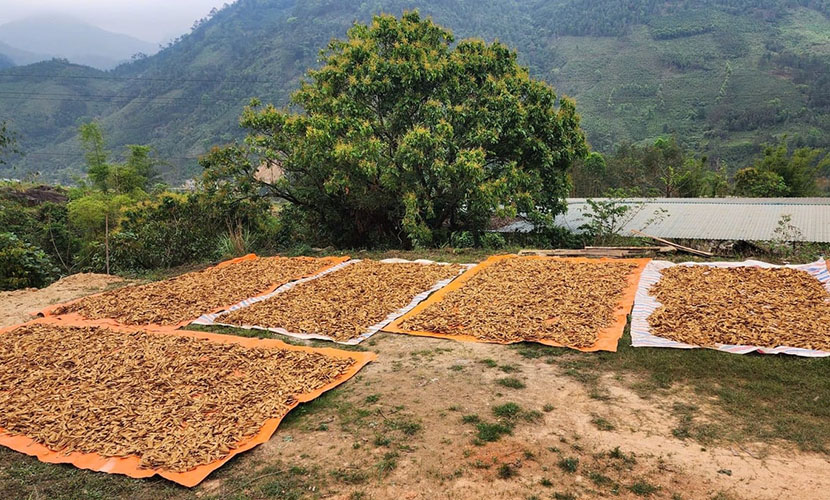
Binh Lieu is a remote district of the mountaineous province of Quang Ninh. The district currently has more than 690 hectares of cinnamon plantations. The development of cinnamon cultivation has contributed to improving local farmer’s income. In 2024, Vietnamese cinnamon barks brought an average income of 75 million VND for each person.
Binh Lieu is entering the cinnamon harvest season, a tree known as the “green gold” of the highland region. With suitable climate and soil conditions, cinnamon grows vigorously, providing a stable income source for local residents.
Huc Dong commune has the largest cinnamon plantation area in the district with more than 400 hectares. Here, the harvesting season is lively and busy. Specifically, this bustling period lasts from the second lunar month to the end of the third lunar month. During this time, people are busy peeling bark, sorting, and drying cinnamon to prepare for consumption.

Vietnamese cinnamon barks
Not only planting cinnamon, many households also participate in purchasing and processing cinnamon to serve both domestic and export markets. Mr. Cam from Khe Mo village grows three hectares of cinnamon, with a half of one hectare currently in harvest. The current selling price for Vietnamese cinnamon barks is 20,000 VND/kg.
Meanwhile, cinnamon branches and scraps sell for 14,000 VND/kg. Since the beginning of the season, he has purchased and processed over twenty tons of fresh cinnamon.
To increase product value, Binh Lieu district has implemented a “four-household” linkage model to cultivate organic cinnamon. They include farmers, enterprises, scientists, and government. Currently, Huc Dong commune has applied this model on over 100 hectares, with participation from many households.
Mr. Duong, Head of the district, said: “We are actively promoting and guiding people to follow organic cinnamon planting procedures. This aims to increase product value and expand the planting area in the near future.”
Although cinnamon provides a stable income, achieving the current results has not been easy for Binh Lieu residents. In the early years of cinnamon planting, many households were hesitant to participate. This was due to the long growth period, high investment capital, and lack of a stable consumption market.

Drying Vietnamese cinnamon barks
Thanks to perseverance and support from agricultural extension programs and sustainable forestry development policies, cinnamon gradually gained recognition. Over time, it established its position within the district’s crop structure.
The district currently has 690 hectares of cinnamon planted across seven communes. The development of cinnamon cultivation has helped increase people’s income. By the end of 2024, the average per capita income reached 75.5 million VND per year.
The district aims to meet the standards of an advanced new rural district by the end of 2025. The target includes achieving an average per capita income of 100 million VND per year.
Currently, Binh Lieu not only focuses on organic cinnamon cultivation but also emphasizes deep processing. This approach aims to create high-value products such as cinnamon essential oil, cinnamon powder, cinnamon tea, and cinnamon-based cosmetics. In doing so, it helps diversify output and increase the value of the Vietnamese cinnamon barks.
In the near future, Binh Lieu district will coordinate with trade promotion units to advertise local cinnamon products to larger markets. The goal is to gradually build the “Binh Lieu Cinnamon” brand as a key OCOP product with national significance.
Vietnamese source: https://nongnghiepmoitruong.vn/cay-que-giup-ba-con-dan-toc-thieu-so-vuon-len-lam-giau-d749557.html
